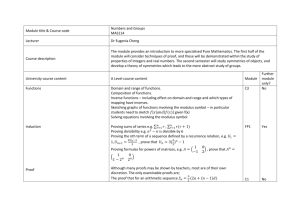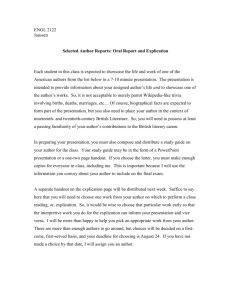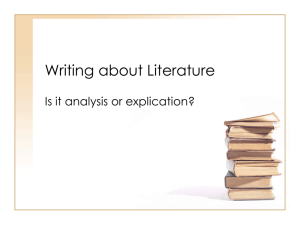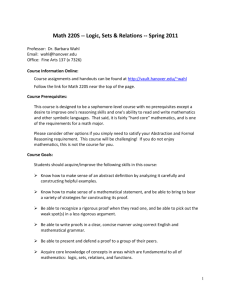Developing an Explication Analytical Lens for Proof-oriented Mathematical Activity
advertisement
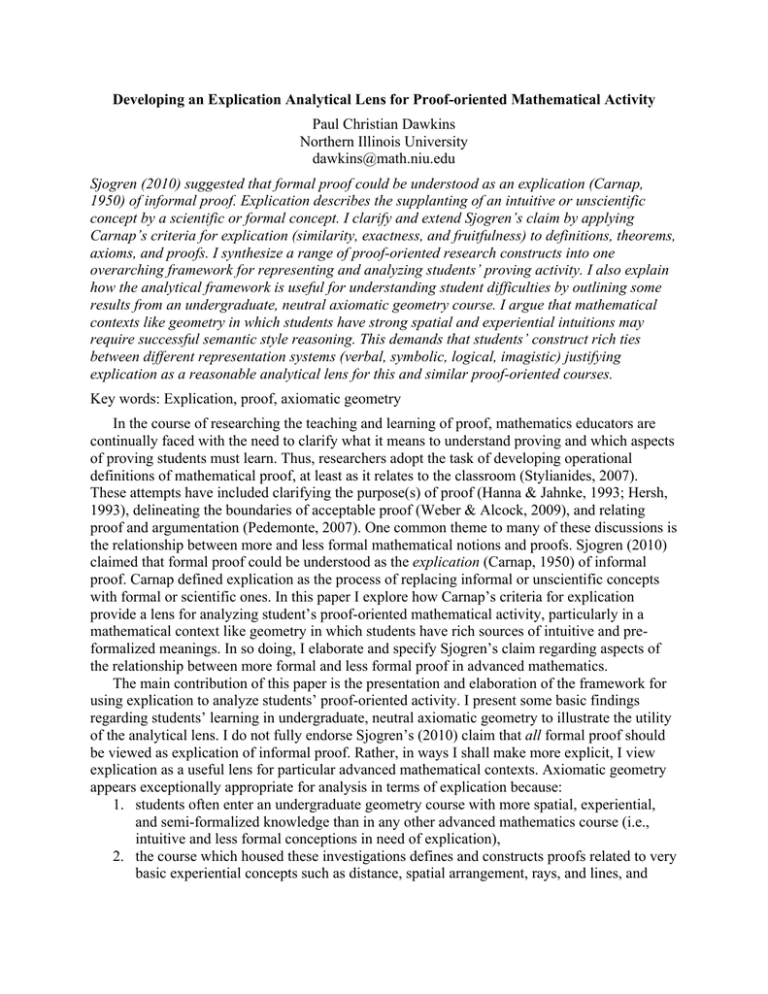
Developing an Explication Analytical Lens for Proof-oriented Mathematical Activity Paul Christian Dawkins Northern Illinois University dawkins@math.niu.edu Sjogren (2010) suggested that formal proof could be understood as an explication (Carnap, 1950) of informal proof. Explication describes the supplanting of an intuitive or unscientific concept by a scientific or formal concept. I clarify and extend Sjogren’s claim by applying Carnap’s criteria for explication (similarity, exactness, and fruitfulness) to definitions, theorems, axioms, and proofs. I synthesize a range of proof-oriented research constructs into one overarching framework for representing and analyzing students’ proving activity. I also explain how the analytical framework is useful for understanding student difficulties by outlining some results from an undergraduate, neutral axiomatic geometry course. I argue that mathematical contexts like geometry in which students have strong spatial and experiential intuitions may require successful semantic style reasoning. This demands that students’ construct rich ties between different representation systems (verbal, symbolic, logical, imagistic) justifying explication as a reasonable analytical lens for this and similar proof-oriented courses. Key words: Explication, proof, axiomatic geometry In the course of researching the teaching and learning of proof, mathematics educators are continually faced with the need to clarify what it means to understand proving and which aspects of proving students must learn. Thus, researchers adopt the task of developing operational definitions of mathematical proof, at least as it relates to the classroom (Stylianides, 2007). These attempts have included clarifying the purpose(s) of proof (Hanna & Jahnke, 1993; Hersh, 1993), delineating the boundaries of acceptable proof (Weber & Alcock, 2009), and relating proof and argumentation (Pedemonte, 2007). One common theme to many of these discussions is the relationship between more and less formal mathematical notions and proofs. Sjogren (2010) claimed that formal proof could be understood as the explication (Carnap, 1950) of informal proof. Carnap defined explication as the process of replacing informal or unscientific concepts with formal or scientific ones. In this paper I explore how Carnap’s criteria for explication provide a lens for analyzing student’s proof-oriented mathematical activity, particularly in a mathematical context like geometry in which students have rich sources of intuitive and preformalized meanings. In so doing, I elaborate and specify Sjogren’s claim regarding aspects of the relationship between more formal and less formal proof in advanced mathematics. The main contribution of this paper is the presentation and elaboration of the framework for using explication to analyze students’ proof-oriented activity. I present some basic findings regarding students’ learning in undergraduate, neutral axiomatic geometry to illustrate the utility of the analytical lens. I do not fully endorse Sjogren’s (2010) claim that all formal proof should be viewed as explication of informal proof. Rather, in ways I shall make more explicit, I view explication as a useful lens for particular advanced mathematical contexts. Axiomatic geometry appears exceptionally appropriate for analysis in terms of explication because: 1. students often enter an undergraduate geometry course with more spatial, experiential, and semi-formalized knowledge than in any other advanced mathematics course (i.e., intuitive and less formal conceptions in need of explication), 2. the course which housed these investigations defines and constructs proofs related to very basic experiential concepts such as distance, spatial arrangement, rays, and lines, and 3. it is difficult to understand and construct many geometric proofs in a completely syntactic style (Weber & Alcock, 2004, 2009) without spatial or imagistic interpretation (i.e.semantic reasoning is often preferable in geometry). Carnap’s (1950) criteria for explication Carnap was a proponent of logical positivism in the sense that he believed in the advancement of knowledge toward objective truth via the expansion of logical and scientific analysis. As such, he viewed explication as an historical phenomenon by which unscientific concepts were replaced by concepts ready for scientific treatment. He claimed a formal concept explicates a less formal one whenever it has similarity, exactness, and fruitfulness. Carnap (1950) provides the example of how temperature explicates warmness. Warmness is an experiential concept that is relative to the observer (the same room may be warm when stepping in from the snow and not warm when stepping out of a sauna). Temperature is similar to warmness in that most experiences of the latter can be expressed and explained in terms of the former. Temperature however differs in that it is an exact concept embedding warmness in a scientific body of theory, namely that of numerical measurement or quantity. Finally, temperature explicates warmness because it is fruitful for the construction of further scientific theory such as the precise numerical relationships among pressure, temperature, and volume (PV=nRT). Fruitfulness is a relative property of any explication that would primarily function to distinguish various possible explications (were several available). My use of explication differs from Carnap’s (1950) in the sense that I am interested in conceptual shifts in the understanding of individual students, a focus that Carnap explicitly distances himself from (calling it “psychologism,” p. 41). As such, I may refer to the processes I analyze in this paper as psychological explication, the process by which an individual supplants or corresponds an intuitive or less formal concept with a formalizable concept appropriate for the construction of mathematical proof. Explication in a body of geometric theory To illustrate how this relates to formal mathematical concepts, I provide several examples of mathematical explications from the body of theory developed in the classroom from which I draw the data presented in this paper. I claim that any element of formal mathematical theory (definition, axiom, theorem, or proof) may at times be a psychological explication of an intuitive or less formal concept. Definitions often explicate informal categories or properties (Alcock & Simpson, 2002; De Villiers, 1998); axioms explicate basic intuitions of number or space; theorems explicate pre-formalized patterns and mathematical phenomena (Stylianides & Silver, 2009); proofs can explicate less formal arguments. The literature on cognitive unity (Antonini & Mariotti, 2008; Pedemont, 2007) explores the question of exactly when arguments and formal proofs correspond more thoroughly than I shall in this paper. To illustrate mathematical explications, consider how the text (Blau, 2008) used in the axiomatic geometry course I studied defines basic geometric objects. Any plane as a collection (P, L, d, [ω], µ) where P is the set of points, L is the set of subsets of P called lines, d:PxP → a real-valued distance function (AB=d(A,B)), ω the sup of the set of all distances (called the diameter of the plane), and µ the angular distance function. Table 1 presents how other geometric concepts are then defined (explicated) from these elements of any plane. Concept Point B lies between points A and C (called a betweenness relation) Intuitive meaning B lies on the direct path from A to C or B is spatially between A and C Notation A-B-C Definition (Blau, 2008) Points A, B, C are distinct and collinear such that AB+BC=AC 2 Line segment with endpoints A and B The ray with endpoint A through point B The section of a line between and including A and B Half-line or all points beginning with A in the direction of B AB Given that 0<AB< ω, AB = A,B ∪ X|A-X-B AB Given that 0<AB< ω, AB = A,B ∪ X|A-X-B ∪ X|A-B-X Table 1. Blau’s (2008) definitions for basic geometric properties and objects in the plane. I claim that each of these formal definitions represents an explication of the associated intuitive concept. For instance, the definition of ray is similar in the sense that the set defined above coincides with rays as they are commonly defined on the Euclidean plane. Blau (2008) defines spherical geometry where every point on the sphere is distinct, lines are great circles, and distances correspond to the length of the minor arc between points. As such, the above definition of a ray on the sphere designates a “half-line” in the sense that it has two endpoints that are antipodes (see Figure 1). The definition of ray is exact because it embeds the spatial relations in a precise body of theory: numerical equations and set theory. The definition is fruitful since the author proved theorems about rays based on this definition and the associated axioms. This final criterion assessing the definition based on its ability to yield formal proof relates closely to Mariotti et al.’s (1997; Antonini & Mariotti, 2008) notion of “theorems” as a triad of statement, proof, and associated body of theory. A definition’s quality as an explication of a concept is intimately related to the associated body of theory and proofs built upon that definition. Euclidean ray Spherical ray X : A-B-X B X : A-B-X A* X : A-X-B X : A-X-B A Figure 1. Imagistic representations of rays in the Euclidean and spherical planes. These definitions are by no means similar in every way to the intuitive concepts they explicate. Distance intuitively corresponds to the space between two points or the distance travelled along a path, but Blau (2008) simply defines distance as a function that obeys certain axioms (positivity “AB≥0”, symmetry “AB=BA”, definiteness “AB=0 iff A=B”, additivity “If AB+BC≤ !, then either AB+BC=AC, BC+CA=BA, or CA+AB=CB”). Rays generally carry a notion of “direction” that is absent from the set-theoretical definition. The second point “B” in a ray is arbitrary, but the definition appears to distinguish it from other points in the ray. The theorem “Given C∈AB such that 0<AC< !, AB=AC” explicates the arbitrarity of the second point in the ray. However, the provability of such theorems simultaneously display the fruitfulness of the explication and restore similarity between formal and less formal concepts (what Weber, 2002, called “proofs that justify axiomatic structure”). An Explication Framework for Proof-oriented Activity The lens of explication assumes a relationship between less formal and more formal conceptions. However, in traditional advanced mathematics classrooms formal theory is often presented as a self-sustaining structure with varying levels of connection to informal or intuitive meanings (Weber, 2004). As such, explications (noun) are presented to students without seeking to engage students in explication (verb) leaving the level of coordination between formal and informal meanings up to the student (what Freudenthal, 1973, 1991, would call an anti-didactical inversion). Thus I shall apply the psychological explication criteria as metrics for measuring cognitive distances between students’ formal and informal conceptions within a conceptual “space”. To be clear, students may lack any conceptions or schemes for activity that correspond to “formal conceptions,” in which case the metric assesses the distance between student conceptions and expert (teacher) conceptions embodied in expectations upon student learning. I draw upon a number of extant constructs to define this “space” for psychological explication. First, as Weber and Alcock (2004, 2009) used Goldin’s (1998) theory of representation systems to distinguish syntactic and semantic reasoning, I shall generally define students’ formal and less formal mathematical conceptions according to the representation system in which they exist. For instance, according to Weber and Alcock (2009), any use of diagrams or images for proving constitutes a shift from the representation system of mathematical proof (RSMP) into an imagistic representation system. This indicates that the student corresponds contents formal statements with less formal instantiations in a diagram. For the definitions involved, this generally involves a shift from the symbolic notation or formal definition of a concept to an example represented by a diagram (generic or particular). In the language of Tall and Vinner (1981) the student has shifted from the concept definition to some element of the concept image. Regarding theorems, a student may seek to prove a theorem by reasoning about an intuitive paraphrase of the statement claim (Dawkins, 2012b). This entails translating the statement from the RSMP into a less formal verbal representation system (like paraphrasing the above theorem to say “The second point in a ray is arbitrary”). Regarding proof, when a student develops an argument or informal proof (I use the term “thought experiment” after Lakatos, 1976) toward formally proving a claim, they often do so based on less formal interpretations without thorough warrants or details. As such, thought experiments may draw from a number of tools outside of the RSMP before it is translated into a form compatible with the RSMP like formal proofs. Figure 2 visually represents this “space” relating the formal and less formal elements in their respective representation systems. The left column represents definitions, the middle column represents theorems or axioms, and the right column represents proof. The upper row represents the explications for the lower row’s less formal elements. The upper elements are related to their neighbor below by similarity. The upper elements are distinguished from the entry below them by their exactness. Finally, the fruitfulness of definitions, axioms, and theorems depends upon their ability to yield appropriately explicated terms to their right in the array (definitions must help articulate theorems that must be provable based on those definitions). I distinguish between the extent to which a formal element matches its informal counterpart (similarity) and the extent to which the informal conception or representation matches its formal counterpart (co-similarity). Exactness Formal definition in RSMP Similarity Statement of theorem/ axiom in RSMP Formal proof in RSMP Intuitive interpretation or paraphrase of theorem/ axiom Thought experiment Co-similarity Intuitive category or property/ Diagrammatic representation/ Exemplars Fruitfulness Figure 2. The space of cognitive elements involved in proof-oriented mathematical thinking. Connections to Prior Research on Proof Production To show the theoretical utility of this representation, it is helpful to illustrate the number of prior theoretical tools and research that informed my construction of it. I use Goldin’s (1998) notion of representation systems reflecting my framework’s conceptual ancestry in the semantic/syntactic dichotomy identified by Weber and Alcock (2004; 2009). They distinguish proof attempts according to whether they stay in the RSMP (the upper row of Fig 2) during their proving activity (called syntactic proof activity) or whether they shift into an alternative representation system (the lower row) to guide their proving via less formal reasoning (called semantic proof activity). Thus, mapping out students proving actions in the space represented in Fig 2 entails identifying which of these two types of proof actions students use (this diagram is a more elaborate transpose of Alcock & Inglis’s, 2009, diagrams for semantic/syntactic proving). The process of psychological explication is strongly related to the Realistic Mathematics Education (Freudenthal, 1973, 1991; Gravemeijer, 1994) emphasis on engaging students in the processes of mathematical activity as a means of mathematical learning. In particular, Zandieh and Rasmussen (2010) adapted Gravemeijer’s (1999) stages of mathematical modeling to the case of students developing a mathematical definition. This process involves students initially forming a concept definition out of a concept image (represented in Fig 2 as movement up in the first column). This stage establishes basic similarity and exactness. Next students reorganize or develop their concept image in light of the new concept definition. This stage entails the creation of a concept image of their concept definition (which I locate in the upper left representation system) and the reorganization of less formal elements of the concept image (in the lower left representation systems). This reorganization of the less formal concept image helps establish cosimilarity. As the definition is extended to new disparate mathematical tasks and contexts, the concept image and concept definition are continually modified to accommodate a broader scope of mathematical activity (Dawkins, 2012a). These latter stages of generalization and formal activity yield the fruitfulness of the explicated definition. Dawkins (2012b) displays how one students’ consistent interpretation of formal statements of theorems and axioms (upper middle) in terms of dissimilar paraphrases (lower center) inhibited his ability to form logically valid proof within the RSMP. The logic of this student’s reasoning appeared inherently descriptive of quasi-empirical phenomena in his mental diagrams (lower left). This fostered a thought experiment that convinced the student, but his reasoning subtly changed the logical structure of the statements to be proven. As a result, his thought experiment lacked exactness because it conflicted with the formal logic of conditional statements in which the theorem to be proven was embedded. Though he produced a thought experiment in a semantic style, the lack of co-similarity in his reasoning undermined his success. Finally, several tools for analyzing students’ proving activity relate thought experiments to formal proofs. As mentioned above, cognitive unity (Mariotti et al., 1997; Pedemonte, 2007) was coined to describe similarity in this regard. Raman (2003) defined key ideas as intuitive or strategic insights that allowed students to explicate a thought experiment. Proof schemes (Harel & Sowder, 1998) distinguish means of convincing that do (deductive) and do not (inductive, by authority) satisfy the exactness criterion for the RSMP. Analyzing Proving with an Explication Lens This analytical lens emerged through analysis of a series of task-based interviews in conjunction with a neutral axiomatic geometry course. Each interview was video-recorded and all written notes were captured with a Livescribe pen. All dialogue was transcribed and qualitatively coded in several stages. First, each interview was “chunked” according to the task students worked on and then into individual proving actions taken by the students. Each proving action was assigned (1) a description summarizing the mathematical activity, (2) codes noting the resources the students drew upon for proving, and (3) codes denoting how the proving action related to the four explication criteria. This analysis allowed me to analyze correspondences between proving actions and the explication criteria. Mapping students’ proving actions within the framework space above provides a visual means of mapping students’ progressions of reasoning during their proof production. Each of the four primary criteria (similarity, cosimilarity, exactness, and fruitfulness) has helped assess students' successful or unsuccessful attempts to prove claims. The ongoing analysis indicates that certain types of proof actions tend to correspond with particular explication criteria. For instance, Kirk often paraphrases formal statements into an informal register (paraphrasing actions) subtly shifting the meaning of the statements leading to a lack of co-similarity (loss of semantic content of the claim) or a lack of exactness (shifts in logical structure of the claim). This sometimes frustrated his proof attempts because the statements he reasoned about or cited as warrants differed non-trivially from the formal statements in the body of theory (Dawkins, 2012b). Oren, Kirk’s interview partner, instead displayed strong intuition and logical reasoning skills, but rarely learned the statements of theorems. He shows a strong preference for diagrammatic reasoning, but often could not translate his visually-produced thought experiments into proofs in the RSMP. This largely resulted from his lack of awareness of available warrants to justify his claims. His diagrammatic reasoning also led him to metonymize related mathematical objects such as points A,B (undefined), distance AB (a number or function value), and ray AB (a set). Table 2 presents how static diagrams of geometric objects lack wholly distinct representations of related objects whose explications differ significantly. The superficial similarity of the symbolic notations exacerbates students’ tendency to metonymize or conflate these objects. Oren’s visual reasoning led him to consistently metonymize geometric objects and to construct thought experiments based on spatial intuition, rather than axioms, definitions, or theorems from the 1 body of theory. As such, his reasoning often lacked exactness (appropriate mathematical structure) and fruitfulness (finding appropriate warrants within the class’ body of theory). Object Explicated Structure Points A, X, and B Undefined Terms Symbolic Representation A, X, B Imagistic Representation Distance between A and B Function value d(A,B) d(AB)=AB A B Segment with endpoints A and B Set of points universally quantified over a betweenness relation AB A B Betweenness A-X-B Property of triplet of collinear points given AX+XB=AB A-X-B A XB Ray with endpoint A through point B Set of points universally quantified over two betweenness relations AB A A B B Table 2. Distinct but related mathematical objects represented in multiple registers. Future Directions The Explication analytical lens has helped in articulating, representing, and analyzing Kirk and Oren’s proving activity in neutral, axiomatic geometry. It also revealed correspondences between the proving actions common to those two students and how they often rendered their proving activity ineffective. The overarching goal of the interviews was to provide the researcher with pedagogically actionable insight into how students act in relation to the body of theory in this course. In light of Kirk and Oren’s challenges and successes, the author piloted a redesigned geometry course focusing on helping students view the formal elements of theory as explications of intuitive geometric concepts. As such, the class engaged in mini-reinvention cycles exploring how the axioms could “model” the known geometric spaces (Euclidean, spherical, and hyperbolic). The author was guided in his teaching method by trying to support students in establishing similarity, co-similarity, exactness, and fruitfulness regarding formal and informal conceptions of key course concepts. Thus, my ongoing research explores how the explication lens can foster insight into students’ proving and how semantic and syntactic elements can be thereby balanced and integrated in proof-oriented instruction (Weber & Alcock, 2009). References Alcock, L. & Inglis, M. (2008). Doctoral students’ use of examples in evaluating and proving conjectures. Educational Studies in Mathematics, 69, 111–129. Antonini, S. & Mariotti, M.A. (2008). Indirect proof: what is specific to this way of proving? ZDM Mathematics Education, 40, 401-412. Blau, H. (2008). Foundations of Planar Geometry. Island Park, NY: Whittier Publications. Carnap, R. (1950). Logical foundations of probability. Chicago, Ill: University of Chicago Press. Dawkins, P. (2012a). Metaphor as a possible pathway to more formal understanding of the definition of sequence convergence. The Journal of Mathematical Behavior, 31(3), 331-343. Dawkins, P. (2012b). Extensions of the semantic/syntactic reasoning framework. For the Learning of Mathematics, 32(3), 39-45. De Villiers, M. (1998). To teach definitions in geometry or to teach to define? In Olivier, A. & Newstead, K., Proceedings of the 22nd Annual Meeting of the International Group for the Psychology of Mathematics Education (2, pp. 248-255), Stellenbosch, South Africa: University of Stellenbosch. Freudenthal, H. (1973). Mathematics as an educational task. Dordrecht: D. Reidel Publishing. Freudenthal, H. (1991). Revisiting mathematics education: The China lectures. Dordrecht: Kluwer. Goldin, G. (1998). Representational systems, learning, and problem solving in mathematics. Journal of Mathematical Behavior, 17, 137–165. Gravemeijer, K. (1999). How emergent models may foster the constitution of formal mathematics. Mathematical Thinking and Learning, 1, 155–177. Hanna, G. & Jahnke, H.N. (1993). Proof and Application. Educational Studies in Mathematics, 24(4), 421-438. Harel, G. & L. Sowder (1998). Students‘proof and schemes: Results from exploratory studies. In H. Schoenfeld, J. Kaput & E. Dubinsky (Eds.) Research in Collegiate Mathematics Education III. Providence, RI: American Mathematical Society. Hersh, R. (1993). Proving is Convincing and Explaining. Educational Studies in Mathematics, 24(4), 389-399. Lakatos, I. (1976). Proofs and refutations. Cambridge, England: Cambridge University Press. Mariotti, M. A., Bartolini Bussi, M., Boero, P., Ferri, F., & Garuti, R. (1997). Approaching geometry theorems in contexts: from history and epistemology to cognition. In E. Pehkonen (Ed.), Proceedings of the 21th Conference of the International Group for the Psychology of Mathematics Education (Vol. 1, pp. 180– 195). Finland: Lathi. Pedemonte, B. (2007). How can the relationship between argumentation and proof be analysed? Educational Studies in Mathematics, 66(1), 23–41. Raman, M. (2003). Key Ideas: What are they and how can they help us understand how people view proof? Educational Studies in Mathematics, 52, 319-325. Sjogren, J. (2010). A Note on the Relation Between Formal and Informal Proof. Acta Analytica, 25, 447-458. Stylianides, A.J. (2007). Proof and proving in school mathematics. Journal for Research in Mathematics Education, 38(3), 289-321. Stylianides, G. & Silver, E. (2009). Reasoning-and-Proving in School Mathematics: The Case of Pattern Identification. In M. Blanton, D. Stylinaiou, & E. Knuth (Eds.), The teaching and learning of proof across the grades: A K-16 perspective. (pp. 235-249). New York: Routledge. Tall, D. & Vinner, S. (1981). Concept Image and Concept Definition in Mathematics with Particular Reference to Limits and Continuity. Educational Studies in Mathematics, 12, 151169. Weber, K. (2002). Beyond proving and explaining: proofs that justify the use of definitions and axiomatic structures and proofs that illustrate technique. For the Learning of Mathematics, 22(3), 14-17. Weber, K. (2004). Traditional instruction in advanced mathematics courses: a case study of one professor’s lectures and proofs in an introductory real analysis course. Journal of Mathematical Behavior, 23, 115-133. Weber, K. & Alcock, L. (2004). Semantic and syntactic proof productions. Educational Studies in Mathematics, 56, 209-234. Weber, K. & Alcock, L. (2009). Semantic and syntactic reasoning and proving in advanced mathematics classrooms. In M. Blanton, D. Stylinaiou, & E. Knuth (Eds.), The teaching and learning of proof across the grades: A K-16 perspective. (pp. 323-338). New York: Routledge. Zandieh, M. & Rasmussen, C. (2010) Defining as a mathematical activity: A framework for characterizing progress from informal to more formal ways of reasoning. Journal of Mathematical Behavior, 29(2), 57-75.
